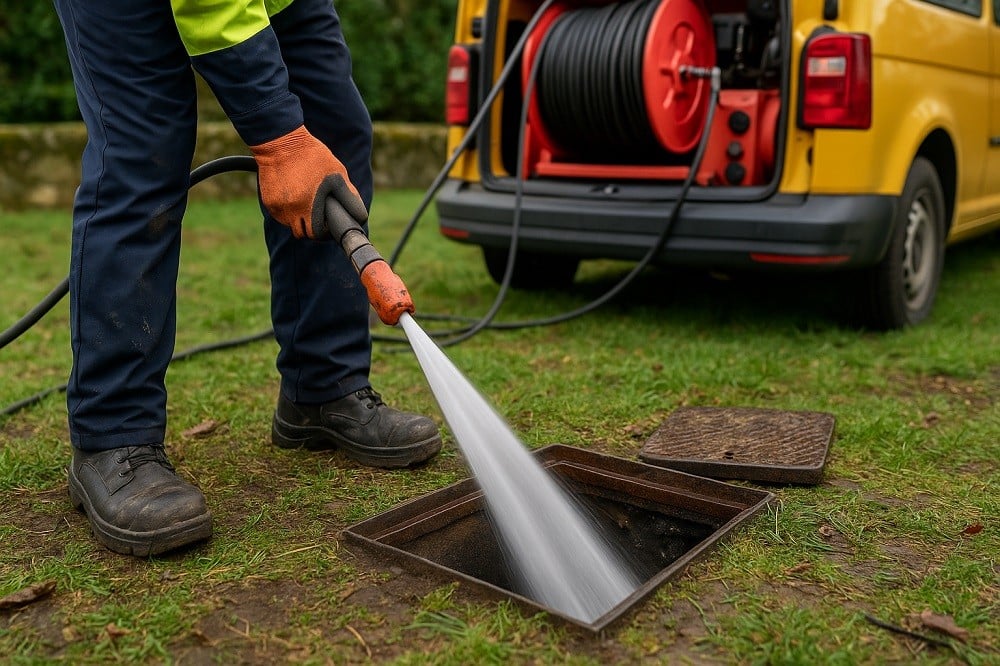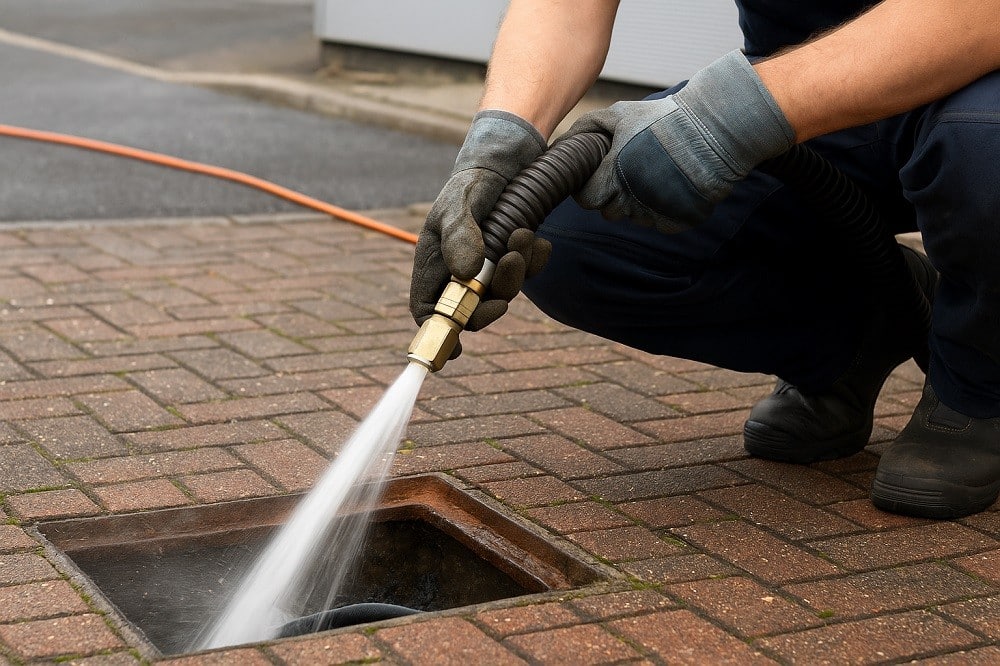
Basic concept and how it works
Drainage jetting uses high-pressure water to dislodge blockages and clean the inside of drainpipes. The technique is both forceful and precise, allowing it to break up grease, silt, tree roots, and debris that typically cause slow drainage or complete blockages. A hose is inserted into the affected pipe, and water is blasted at pressures often exceeding 3,000 PSI, depending on the drain type and severity of the blockage.
The power of the water alone is enough to dislodge stubborn materials, meaning no harsh chemicals are required. That makes it an environmentally considerate option as well as a highly effective one.
Equipment involved
Drainage jetting relies on several key components. The main unit includes a water tank, pump, pressure gauge, and hose reel. Nozzle types vary based on the application — some are designed to bore through debris, while others spray backwards to pull the hose further into the pipe, cleaning as they go.
For residential jobs, smaller jetting machines are mounted on vans. For commercial or large-scale work, more powerful systems are installed on lorries or trailers, often with vacuum suction to remove displaced waste.
Common blockages it resolves
Fatbergs, congealed soap, sanitary products, and tree roots are common causes of blocked drains. Drainage jetting deals with these quickly. It can also clear sediment build-up in older clay pipes or concrete obstructions caused during building work. This versatility makes it suitable for almost any scenario, from kitchen sinks to deep sewer lines.
Why Drainage Jetting Is So Effective
Pressure and precision
High-pressure jetting combines raw power with targeted direction. Water hits the blockage with intense force while nozzles control the angle and spray pattern. This ensures not only that the obstruction is removed, but that the pipe walls are also cleaned — reducing the risk of future build-up.
Comparisons with traditional rodding
Drain rods have long been used to manually push or twist through clogs. While effective for soft blockages close to the surface, they lack the reach and cleaning capability of jetting. Rods often just poke a hole through the material, allowing temporary flow but leaving much of the debris behind. Jetting flushes everything out, restoring the pipe to near-original condition.
Benefits for domestic vs commercial systems
In homes, drainage jetting quickly clears blockages in kitchen waste pipes, bathroom drains, and garden gullies. For commercial settings — like food establishments, factories, or housing associations — jetting serves as both a reactive and preventive tool. Regular jetting helps maintain high-traffic pipework, avoiding costly downtime and repair.
When to Use Drainage Jetting
Early signs of a blocked drain
Slow-draining sinks, gurgling noises, and foul odours can all point to developing blockages. Catching these signs early allows jetting to be used proactively before more severe flooding or overflow occurs.
Routine maintenance vs emergency response
Many property managers and businesses schedule periodic jetting as part of drain maintenance. This approach prevents blockages from forming in the first place. However, jetting is also an ideal emergency tool. Its speed and power make it perfect for resolving complete drain failures.
Situations where jetting isn’t suitable
While versatile, drainage jetting isn’t always the right option. In collapsed or severely damaged drains, the pressure could worsen structural issues. In these cases, a drain survey should be carried out first to assess pipe integrity. Jetting is also ineffective against hard obstructions like cement or building waste that may require mechanical cutting.
The Jetting Process Step-by-Step

Site assessment and planning
Before any equipment is switched on, the engineer conducts a site assessment. This involves identifying access points, determining pipe size, and evaluating any risks. If there’s uncertainty about the blockage location or cause, a drain survey may be performed first to guide the jetting process.
Accurate planning ensures that the right nozzle type, hose length, and pressure settings are used. It also helps avoid damage to older or fragile pipework.
Safety checks and access points
Jetting involves powerful machinery, so safety comes first. Operators wear protective clothing and eye protection, and the area around the drain is secured. Access points such as inspection chambers or rodding eyes are opened, and the hose is inserted carefully.
If the drain has multiple branches or changes in direction, flexible hose and rotating nozzles are used to navigate corners and reach deeper blockages.
Jetting in action: what to expect
Once everything is in place, the pump is engaged and high-pressure water is released. The nozzle blasts forward to dislodge debris while dragging the hose deeper into the pipe. Simultaneously, dislodged waste is flushed backwards toward the drain exit.
Within minutes, blockages are cleared and water flows freely. Engineers usually monitor flow and pressure throughout to ensure no secondary issues arise. Once finished, the system is tested and access covers are securely replaced.
The Role of Jet Vac Tankers in Drain Jetting
What Are Jet Vac Tankers and how they assist
What Are Jet Vac Tankers ? Jet vac tankers are large vehicles equipped with both high-pressure jetting systems and vacuum suction units. They play a crucial role in industrial and large-scale drain maintenance. Where a domestic jetting machine cleans the pipe, a jet vac tanker can also extract the resulting sludge and waste in real time.
This combined functionality makes them ideal for sites with heavy grease, oil, or debris that could overwhelm standard drainage systems.
Jetting in large-scale and remote locations
Construction sites, industrial estates, and large residential blocks often require powerful equipment to reach deep or wide networks of pipework. Jet vac tankers can carry longer hoses and larger water tanks, meaning they can operate for extended periods without refilling.
In remote areas without easy drainage access, the vacuum system stores the waste for safe disposal off-site. This ensures the job is both efficient and environmentally responsible.
Waste collection and environmental considerations
Jet vac tankers reduce the risk of contamination by collecting and containing waste material. Licensed operators dispose of the waste in accordance with UK environmental regulations, protecting nearby water sources and soil.
Using jetting in combination with vacuum extraction helps avoid pollution, especially when clearing oil separators, interceptors, or floodwater drains.
Choosing the Right Blocked Drain Company
What to look for in a reliable provider
When selecting a blocked drain company, experience matters. Technicians should be trained, insured, and equipped to handle both domestic and commercial systems. Clear communication and the ability to explain the issue without jargon are also good signs.
It’s worth checking whether the company uses modern equipment, offers fixed pricing, and can provide CCTV surveys to verify their work.
Pricing transparency and emergency availability
Blocked drains don’t wait for office hours. A reliable provider should offer 24/7 emergency response and clearly explain their pricing before work begins. Hidden charges or vague estimates often signal a lack of transparency.
Look for companies that back their services with a ‘no fix, no fee’ promise or similar guarantee.
The benefit of local expertise
A local company understands the common causes of blockages in the area — from root intrusion in older clay pipes to kitchen waste in high-density housing. That insight means faster diagnosis and more tailored solutions.
How Drain Surveying Supports Drainage Jetting
Identifying the blockage before jetting
Before high-pressure jetting begins, it’s often useful to pinpoint the exact cause and location of the problem. Drain surveying allows engineers to inspect the pipework using specialist cameras, removing the guesswork and confirming that jetting is the right solution.
CCTV surveys can detect obstructions, damage, or collapsed sections that might not respond well to water pressure. This preventative step protects both the system and the operator’s time.
Post-jetting inspection and reporting
After jetting, a second survey is sometimes performed to verify that the blockage has been fully cleared. The inspection footage offers visual confirmation, making it easier to assure clients and support any necessary repair quotes.
Some companies include a full digital report with images and recommendations, which can be helpful for landlords, facility managers, or insurance claims.
Long-term maintenance planning
Data gathered during a drain survey can inform maintenance schedules. If jetting is needed regularly due to heavy use or root intrusion, the client can be advised on how often to book service. Early intervention can also reduce wear and tear on the system.
In commercial settings, combining surveying and jetting creates a proactive approach to drainage care — saving money over time and reducing the likelihood of downtime.
Final Thoughts on Drainage Jetting
Why jetting remains the go-to solution
Drainage jetting offers a fast, effective way to clear stubborn blockages. Its combination of pressure and precision makes it suitable for most systems, from household sinks to industrial drains. With minimal disruption and no chemicals involved, it’s a safe and efficient solution trusted by professionals across the UK.
Combining technology with expertise
Jetting is only as effective as the team operating it. The best results come from providers who combine modern equipment with practical experience. Whether it’s knowing when to scale up to a jet vac tanker or when a drain survey is required first, the engineer’s judgement is key.
Preventing future issues through proactive care
Blockages often build up slowly, making them easy to overlook until the system fails. Regular jetting, backed by accurate surveying, helps prevent costly disruptions. It also improves the overall health of the drainage network, extending its lifespan and performance.
From clearing minor kitchen waste to tackling industrial sludge, drainage jetting remains the most reliable method for keeping things flowing.
Recent Posts
- Guide to Clearing Blocked Drains: Causes & Solutions November 24, 2025
- Drainage Jetting Explained: How It Clears Blocked Drains October 25, 2025
- Clean Out Gutters Like a Pro: Step-by-Step Guide October 25, 2025
- CCTV Drain Inspection for Detecting Tree Root Blockages August 14, 2025
- How To Clear Roots From Drain Pipes July 11, 2025
Categories
- Drain Repairs (40)
- Drain Surveys (24)
- Drain Unblocking (60)
- Rodent Drain Problems (1)
- Uncategorized (2)
- Vacuum Tankers (2)
